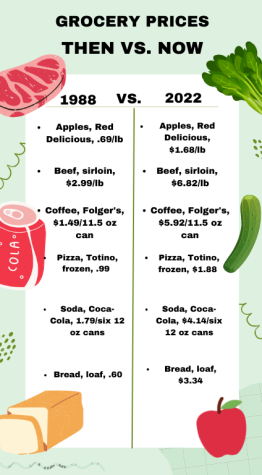Prices rise, but their incomes don’t
Inflation heavily impacts people living on fixed incomes
January 23, 2023
I am halfway through my four-hour shift at my part-time job at a grocery store. I am a cashier, and the lines are slow. A woman comes up to my register. We make casual conversations. She shares with me that she lives in a senior living facility and looks forward to doing her own shopping. She also jokes that it has been a long time since she has treated herself to anything sweet.
She loads her items onto the checkout counter and I proceed to ring them up. I give her the final total, which is a little over $130. She tells me that she fears that she will not have enough money. I ask her if there are any items she would like to take off, and she begins to take off items in order of their importance.
I feel very sad.
The truth is, scenes such as this are happening all over the world. As of December 2022, prices have increased by 6.5% compared to December 2021. Inflation affects all people differently, but one experience that has been overlooked is that of people who live on fixed incomes.
What has caused inflation?
Increased inflation has many possible causes. According to Forbes Advisor, inflation has risen due to a combination of “pent-up consumer demand, supply chain disruptions, and a tight labor market.” The shopping habits of consumers overall have been affected, changing as a result of increased inflation.
What does it mean to live on a fixed income?
To live on a fixed income means to depend mostly or entirely on payments from a source that does not vary or rise with the rate of inflation. Some examples include Social Security, pensions, and/or retirement savings. Recipients may be retired or disabled workers. According to the United States Social Security Administration Fact Sheet, the average monthly Social Security Insurance (SSI) payment is $1,669.
What is the CPI?
The Consumer Price Index (CPI) measures the change over time that consumers pay for various goods and services. It is an indicator of how much people’s money is really worth. Retirees tend to spend most of their money on food, healthcare, and housing–all of which are heavily impacted by inflation. As of December 2022, food prices increased by 10.4%.

As inflation increases, purchasing power decreases
It can be assumed that people who are retired in 2022 were a part of the workforce 30 years ago. In 1988, $1,669 (the average monthly SSI payment) has the same buying power as $972 in 2022. Nearly $700 of purchasing power is gone. People who depend on social security payments will not experience a wage increase. What they will experience are economic hardships, and to ease this burden brought on by inflation, businesses could be doing more to aid consumers living on fixed incomes.
What can be done?
Across the country, businesses and service providers are offering discounts for seniors. Some senior discounts are based solely on age, with eligibility often starting from the age of 50. Often, discounts are more exclusive and can be inaccessible. Extending discounts or lowering prices is unrealistic, as most corporations will not accept a decrease in profit. One possible solution is to increase social security benefits so that people are not as hard hit by inflation. According to the US Social Security Administration, payments will increase by 8.7%, and there is a possibility that this can help ease the burden of rising inflation.













